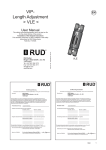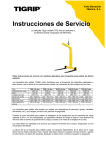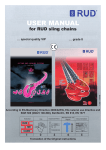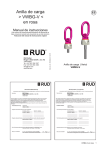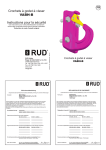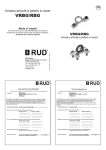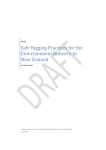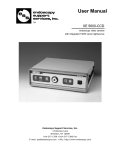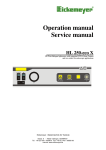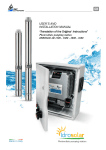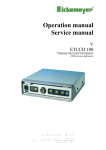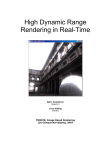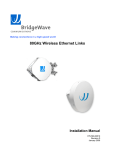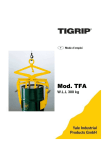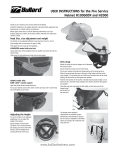Download User manual For RUD-ICE-lifting chains in Grade 120 - IT
Transcript
User manual For RUD-ICE-lifting chains in Grade 120 Certified by the BG (Employers Liability Insurance Association) Metal North South Technical Committee Metal and surface treatment Certificate Authority in BG PZNM Translation of the Original instructions According to EG-Machinery Directive 2006/42/EG, EG material use directive and BGR 500 / DGUV 100-500 chapter 2.8, EN 818, EN 1677. 1 Determined usage for lifting and transportation of loads 1. Selection of lifting chains 1.1 Weight 1.4 Asymmetrical loads The weight of the load must be known. 1.2 Centre of gravity The centre of gravity of the load must be known. 1.3 Method of lifting For multiple leg lifting the inclination angle should be chosen between 15° and 60°. Inclination angles exceeding 60° create overloading of the lifting chain, inclination angles under 15° can lead to instability of the load. When using choke hitches, the WLL must be reduced to 80 % of the indicated WLL. In applications using a 4-leg sling there is always the danger that only the 2 diagonally opposite legs are load bearing, even when the load is symmetrical! 1-leg If one leg must be shortened in multiple leg application, this could be an indication for an uneven load, which should be verified by a competent person. Acc. to BGR 500 / DGUV 100-500 section 2.8, the WLL for single fall becomes valid when unsymmetrical load occurs at a multiple strand sling. 1.5WLL WLL in tons at symmetrical loading (see table): 2-leg 3- and 4-leg endless chain sling in choke hitch Diameter of the lifting chain in mm Inclination angle ß load factor Ø 4 Ø 6 Ø 8 Ø 10 Ø 13 Ø 16 endless 0° 1 0.8 1.8 3.0 5.0 8.0 12.5 0-45° 1.4 1.12 2.5 4.25 7.1 11.2 17.0 >45-60° 1 0.8 1.8 3.0 5.0 8.0 12.5 0-45° 2.1 1.7 3.75 6.3 10.6 17.0 26.5 >45-60° 1.5 1.18 2.7 4.5 7.5 11.8 19.0 1.6 1.25 2.88 4.8 8.0 12.8 20.0 Acc. to BGR 500 / DGUV 100-500 section 2.8, the WLL for single fall becomes valid when unsymmetrical load occurs at a multiple strand sling. For lower or higher WLL up to 126 t, please select the most suitable chain designed from the VIP-10 Program! RUD ICE-120-Chains and components are designed in accordance with DIN EN 818 and 1677 and withstand a dynamic loading of more than 20,000 load cycles. 2 The BG recommends: when there is high dynamic application and a permanent operation, the bearing stress must be reduced according to Mechanism group 1Bm (M3 according to DIN EN 818-7), e.g. by using a larger chain diameter. endless chain Diameter of the lifting chain in mm Inclination angle ß load factor Ø 4 Ø 6 Ø 8 Ø 10 Ø 13 Ø 16 Temperatur °C 1.6 single 0-45° >45-60° 1.1 0.8 0.88 0.64 2.0 1.44 3.3 2.4 5.5 4.0 8.8 6.4 14.0 10.0 choke hitch double 0-45° >45-60° 1.7 1.2 1.36 0.96 3.1 2.1 5.1 3.6 8.5 6.0 13.6 9.6 21.2 15.0 single 0° 0.8 0.64 1.44 2.4 4.0 6.4 10.0 double 0-45° >45-60° 1.1 0.8 0.88 0.64 2.0 1.44 3.3 2.4 5.5 4.0 8.8 6.4 14.0 10.0 Acc. to BGR 500 / DGUV 100-500 section 2.8, the WLL for single fall becomes valid when unsymmetrical load occurs at a multiple strand sling. When using lifting chains at temperatures beyond 200°C (refer to page 4), the permissible WLL has to be reduced. Working load in % at chain temperature of: -60 up to +200°C 100 % obove 200 up to 250°C 90 % Assembly set, clevis connection quality grade 120 (ICE) ICE-Masterlinks are equipped with a weld-in free moveable clevis connector. The outcome of this is a “foolproof” connection regarding the chain diameter and the number of legs. The masterlink also offers an identification tag with an integrated gauge function. The connecting- and the securing pin are already pre-assembled. The RUD-system consisting of ICE-Clevis connection and the oval load pin are making the assembly easy. The RUD-ICE clevis connection system provides by the dimensioning and the foolproof system necessarily the correct allocation of the correct ICE nominal chain diameter. Clevis width X avoids assembly of a bigger chain. Pin diameter dimension Y avoids the assembly of a smaller chain. Only the correct ICE chains and the corresponding ICE-parts of the same nominal diameter are supposed to be assembled. obove 250 up to 300°C 60 % FOOL PROOF SYSTEM Attention: - ICE quality grade 120: Only chains, components and connecting pins which are embossed with ICED1-12 must be used. - Sleeve pin for the securing of the load pin must be installed with the groove showing to the outside. - Use sleeve pin only once. - Use only original RUD-ICE spare parts The assembly of chains and components from different manufacturers is not allowed! = Identification of the complete assembled chain slings. = this mark confirms that the technical requirements of the European Directives are fulfilled. Please note the following regulations: EN 818-1, EN 88-2, EN 818-4, EN 1677, BGR 500 / DGUV 100-500 chapter 2.8 and the corresponding country-specific regulations. We do not take any responsibility for damage occurred by non-conformance of these standards, regulations and hints! 3 Assembly-system with IC ICE-UNIVERSAL-SYSTEM Universal coupler system, chains and components are not foolproof by using the ICE-Connector. When assembling and repairing, it is necessary to pay particular attention that the chains, master links and components are of the same nominal size! The nominal size and number of legs stamped on the master link must be observed during assembly! Attention: - Use retaining pins only once! - Identification must be correct! - Use only original spare parts! - Do not mix with chains and components from other quality classes, e.g. VIP or Grade 80! Chain 10 mm 1-leg Example: NON FOOL PROOF SYSTEM!!! 2 Usage for lifting chains When using lifting chain assemblies, attention must be paid according to the regulations BGR 500 / DGUV 100500, chapter 2.8 “Betreiben von Lastaufnahmeeinrichtungen im Hebezeugbetrieb” or other specific country statutory regulations (out of Germany). Whenever it is possible leave the danger zone. Never leave lifted loads unattended. Be sure before the first lift that: - the chain assembly corresponds to the ordered ones - the test certificate of the factory approval (form EN 10204 with the details from EN 818-4) and declaration of conformity is present - the details marked on the identification tag of the assembly correspond to the specification on the test certificate and the declaration of conformity - the details are registered in the chain card file. This documentation should include a description of the chain assembly, as well as the proof of identity (test certificate resp. declaration of conformity ref. no.). 4 1/10 2/8 1.7 Chain 8 mm 2-leg A failure to follow the assembly instructions can lead to personal and material damage! 2.1 Handling Lifting chains must be used with straight legs without twists, knots or breaks. Load hooks must not be tip loaded and must be equipped with safety latches to avoid unintentional unloading. Before the usage of hooks without a safety latch a risk assessment has to be carried out and the whole operation must be made extra careful. When using chain shorteners DIN 5692:2011-4 must be observed in regard to the technical requirements. Master links must be free moveable at the bowl of the crane hook. Before hanging the non fool proof masterlink into the crane hook, the ICE-Connectors and the ICE Shorteners must be positioned in such a way that they are located underneath the flattend zone of the masterlink before loading. When components are modified by the user, the health and safety requirements must be amended and the risk assessment must be anewed and corresponding actions carried out. Avoid shock loading. Sharp edges are bending or damaging chain links and components. In this case use either edge protection, next bigger chain size or reduce the WLL by 20 %. ICE-AGH Application Close IAGH manually 2.2 2.3 Locking lever up = IAGH is locked Locking lever puseg down = IAGH can be opened Multi – leg sling chains where not all individual legs are used Application of the lifting means Number of individual used legs Load factor for the nominal WLL 2-leg 3- and 4-leg 3- and 4-leg 1 2 1 1/2 2/3 1/3 Storage of sling chains Sling chains should be stored on racks in hanging conditions. 5 2.4 Influences of high and low temperature If sling chains are used in temperatures ranging from 200°C upwards (e.g. in hot environments such as steel production, forges, foundries etc.) the WLL has to be reduced according to the following table. °C % -60° up to +200°C 100 % With temperatures under -60°, the ICE-lifting chains must not be used. Temperatures ranging from 300°C upwards are not allowed. Reduced WLL in % where the chain slings reaches temperatures of: above 200° up to 250° 90 % above 250° up to 300° 60 % The special fluorescent ICE-pink powder coating signals permanently the maximum temperature at which the ICE chain had been used. Once pink colour changes into brown-black, ICE chains must be replaced or sent back to manufacturer for inspection. (The pink colour changes to brownblack when the chain is used in temperature areas higher than 300°C.) 2.5 Chemical influences Sling chains of ICE special quality 12 must not be used under chemical influences (acids, alkaline solutions and vapors), e.g. in pickling baths or hot dip galvanizing plants. Attention should be paid to special instructions such as BGR 150 / DGUV 109004 or other country specific statutory regulations. 3 Inspection and test 3.1 Visual and function test For controlling sling chains, regular inspection by an expert have to be carried out within a period of 12 months. Depending on the conditions of use, e.g. permanent usage, increased wear or corrosion, the inspection needs to be carried out earlier. The expert has to record the examination in the chain card file. Protocols of tests and any other records have to be kept. Should any of the following damage occur, the sling chain should immediately be taken out for maintenance and service: 6 2.6 Other influences Before using sling chains in chemicals, the manufacturer must be contacted first regarding the concentration, period of penetration and temperature of use. a) The identification tag is unreadable or the tag is missing. b) Twisting, deformation and breakage of chains, components and master links. c) Lengthening of the chain by plastic deformation of individual links by more than 5 % referred to the pitch of 3d. Max. allowed wear on the ICE oval bolt: 15 % d) Wear occurs at the chain links caused by abrasion on the outside and at chain the interlink zone. dm = average link width d1/d2 = actual sizes d = nominal size For measuring the wear with a calliper, the chain must be loose. A wear up to 10 % (dm) is permissible. e) Cuts, notches, grooves, failure, increased corrosion, discolouring due to heat, bent or twisted chains and components. Especially deep notches in the tensile strength region and sharp-edged notches in lateral direction are not allowed. f) The width of the (hook) mouth must not exceed 10 % of the nominal value. See embossed markings and maximum measuring value Fmax. The safety latch must slip into the hook tip in order to occur from closure. Carefully examine bowl of the hook in regard of notches. 4 3.2 Examination for cracks Inspections going further than just visual checking, the corresponding national regulations have to be fulfilled. RUD recommends, respectively to BGR 500 / DGUV 100-500 chapter 2.8, to do a crack test inspection at least after 3 years. A proof load test for chains and components is insufficient because cracks can only be recognized with a magnetic crack test. Testing wear of nominal diameter Testing plastic elon- Testing pitch gation elongation caused by caused by overloading wear of nominal diameter ICE Identification tag with integrated chain testing gauge - the patented idea- Repair and Maintenance Repair works have only to be done by experts, disposing the knowledge and skills required. Components and chains with failures, being bent, twisted and considerably deformed must be exchanged. With the chain, the complete leg has to be replaced. Minor faults such as notches and grooves have to be grind off carefully (to avoid notch effect). The cross section of the material must not be decreased by more than 10 % Welding on chains and components is forbidden. Maximum allowed wear of pin diameter = 15 %. Fundamentally, use new connecting bolts and tensioning sleeves when changing these parts! Use only original RUD spare parts! It is only allowed to connect ICE chains with ICE components (stamped with “ICE”). All carried out repairings must be documented in the chain card file resp. if RUD-IDNet® is used, make notes in the database. It is not allowed to combine ICE chains and components from other manufacturers! 7 5Documentation Chain card file The chain card file contains the continuous history of a chain sling. The contents are: first record (paragr. 2), inspection/test dates (paragr. 3) as well as repair and maintenance (paragr. 4). If there are any repairs, the reason must be indicated. The records in the chain card file give proof on steady supervision measurements of the user during the use of the sling chains. Carefully adhere to statutory requirements and the approval code of practise issued by the trade association. Our test personnel are well educated specialists according to EN 473 working with the most modern equipement. Test certificate according to BGR 500 / DGUV 100-500 as well as actual EU law. Testing equals safety and keeps the value added. The RUD inspection service offers you the complete safety service directly on the field. We are testing every lifting mean according to the beside mentioned 6 points safety program. Service-Telefon: 0049 7361/504-1351 RUD Ketten Rieger & Dietz GmbH u. Co. KG 73428 Aalen Tel. +49 7361 504-1351-1370-1262 Fax +49 7361 504-1460 [email protected] www.rud.com REGISTRATION VISUAL CONTROL CRACK TESTING MAINTENANCE CERTIFICATION HinT It is not allowed to combine ICE-chains and components with chains and components quality class 8 or 10. 5.2RUD-ID-NET®Applikation The ICE-components will be equipped with a RUDID-Point® and can clearly be related by the identification number. This number can be determined with the RUD-ID-EAS-CHECK® readers and data can be transferred into the RUDID-NET®-Application. The application will support your product administration and documentation. For further information please go to the RUD webpage or ask your RUD authorized distributor. EG-Konformitätserklärung EC-Declaration of conformity entsprechend der EG-Maschinenrichtlinie 2006/42/EG, Anhang II A und ihren Änderungen According to the EC-Machinery Directive 2006/42/EC, annex II A and amendments Hersteller: RUD Ketten Rieger & Dietz GmbH u. Co. KG Manufacturer: Friedensinsel 73432 Aalen Hiermit erklären wir, dass die nachfolgend bezeichnete Maschine aufgrund ihrer Konzipierung und Bauart, sowie in der von uns in Verkehr gebrachten Ausführung, den grundlegenden Sicherheits- und Gesundheitsanforderungen der EG-Maschinenrichtlinie 2006/42/EG sowie den unten aufgeführten harmonisierten und nationalen Normen sowie technischen Spezifikationen entspricht. Bei einer nicht mit uns abgestimmten Änderung der Maschine verliert diese Erklärung ihre Gültigkeit. Produktbezeichnung: Anschlagkettengehänge Gk12 ICE _____________________________________________ ND 4-16 mm, verkürzbar und unverkürzbar _____________________________________________ Folgende harmonisierten Normen wurden angewandt: EN 12100 : 2011-03 _________________ EN 1677-2 : 2008-06 _________________ EN 1677-4 : 2009-03 _________________ EN 818-2 : 2008-12 _________________ EN 818-6 : 2008-12 _________________ EN 1677-1 : 2009-03 _________________ EN 1677-3 : 2008-06 _________________ EN 818-1 : 2008-12 _________________ EN 818-4 : 2008-12 _________________ _________________ Folgende nationalen Normen und technische Spezifikationen wurden außerdem angewandt: BGR 500, KAP2.8 : 2008-04 _________________ DIN 15429 : 1978-07 _________________ DIN 5692 : 2011-04 _________________ _________________ _________________ DIN 15428 : 1978-08 _________________ DIN 5688-3 : 2007-04 _________________ PAS 1061 : 2006-04 _________________ _________________ _________________ Für die Zusammenstellung der Konformitätsdokumentation bevollmächtigte Person: Reinhard Smetz, RUD Ketten, 73432 Aalen Aalen, den 09.05.2014 8 MEASURING Dr.-Ing. Arne Kriegsmann,(Prokurist/QMB) _____________________________________________ Name, Funktion und Unterschrift Verantwortlicher RUD Ketten Rieger & Dietz GmbH u. Co. KG Friedensinsel 73432 Aalen We hereby declare that the equipment sold by us because of its design and construction, as mentioned below, corresponds to the appropriate, basic requirements of safety and health of the corresponding EC-Machinery Directive 2006/42/EC as well as to the below mentioned harmonized and national norms as well as technical specifications. In case of any modification of the equipment, not being agreed upon with us, this declaration becomes invalid. Product name: Chain sling Grade 120 - ICE _____________________________________________ ND 4-16 mm, adjustable/not adjustable _____________________________________________ The following harmonized norms were applied: EN 12100 : 2011-03 _________________ EN 1677-2 : 2008-06 _________________ EN 1677-4 : 2009-03 _________________ EN 818-2 : 2008-12 _________________ EN 818-6 : 2008-12 _________________ EN 1677-1 : 2009-03 _________________ EN 1677-3 : 2008-06 _________________ EN 818-1 : 2008-12 _________________ EN 818-4 : 2008-12 _________________ _________________ The following national norms and technical specifications were applied: BGR 500, KAP2.8 : 2008-04 _________________ DIN 15429 : 1978-07 _________________ DIN 5692 : 2011-04 _________________ _________________ _________________ DIN 15428 : 1978-08 _________________ DIN 5688-3 : 2007-04 _________________ PAS 1061 : 2006-04 _________________ _________________ _________________ Authorized person for the configuration of the declaration documents: Reinhard Smetz, RUD Ketten, 73432 Aalen Aalen, den 09.05.2014 Dr.-Ing. Arne Kriegsmann,(Prokurist/QMB) _____________________________________________ Name, function and signature of the responsible person Gü-M/7995555/02-015 5.1









